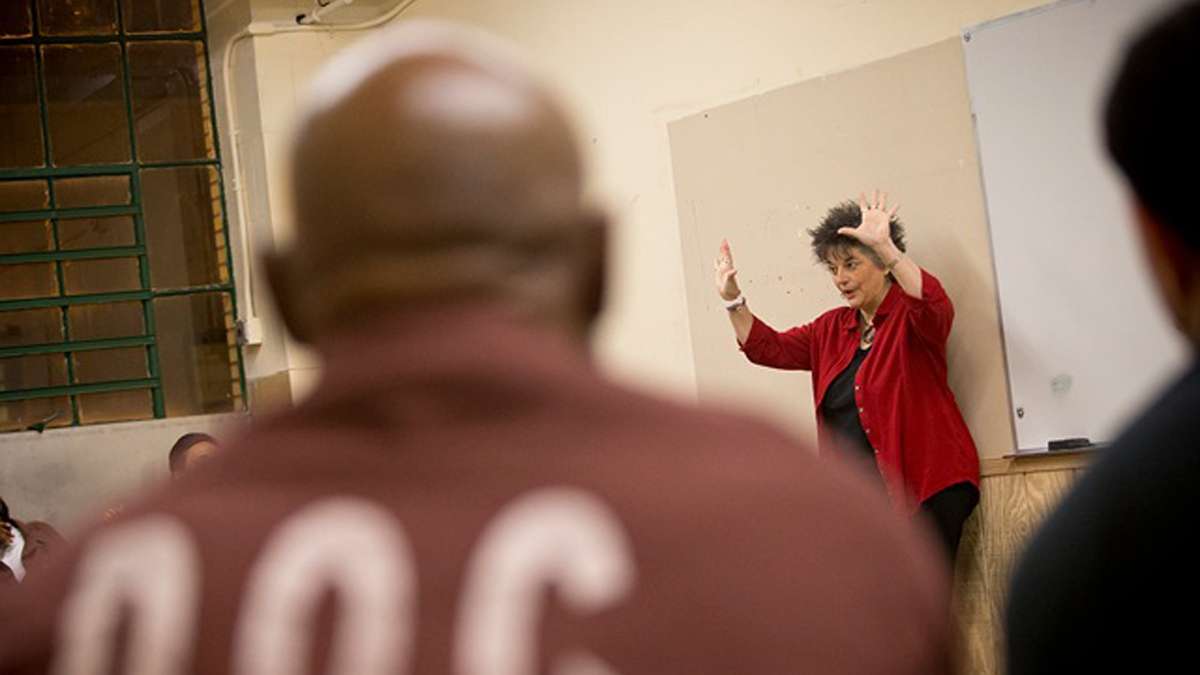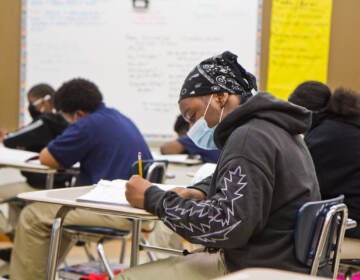Temple class inside prison lets undergrads and inmates learn from each other
ListenEach week, students from Temple University head to class. But first, they have to clear security. Once they’re inside 30-foot-high walls, the learning begins, as part of a program that puts college kids side-by-side with maximum-security inmates.
In some ways this looks like any other college class: Students sit in a nondescript room in a big circle, wearing Temple University shirts and holding notebooks. But the circle embraces other students.
The shirts they wear are stamped with three letters: D. O. C.
Department of Corrections.
John is an inmate at Graterford, a Pennsylvania state prison in Montgomery County. He says the Inside-Out Prison Exchange class is the highlight of his week. (Editor’s note: Graterford allowed WHYY/NewsWorks to sit in on the class on condition that only first names of students would be used, which is the practice during the Inside-Outside class.)
“It helps me learn more about the criminal justice system.” John said, “What I can do to better myself — to not come back here.”
Challenging assumptions
The Temple students travel to the prison once a week for the class. Shanae, a Temple senior, says she’s learned unexpected things inside these prison walls.
“What really surprised me was how smart these men were,” she said. “I didn’t expect that but they’re really intelligent.”
In this room the “inside students” — the ones who won’t be leaving Graterford when the class is done — walk free without shackles. Many carry notebooks. They can get credit for the class now if they are in a college program, or retroactively if they get out and go to Temple.
Lori Pompa is the founder and director of the Inside-Out Prison Exchange program. She says a lot of the students — both “inside” and “outside” — go into the course with assumptions about their classmates.
“It’s when we come face-to-face with those assumptions and we’re placed into a situation that is very much outside of our comfort zone, it challenges us to look at things about ourselves,” Pompa said.
Getting to the root causes of crime
Pompa started the program in the Philadelphia jails in 1997. Five years later, she brought it here to Graterford.
There are Inside-Out courses throughout the United States and Canada. The program is soon to be replicated in a number of other countries, including Australia and the United Kingdom.
As this class begins, after some last-minute shuffling of chairs and chatter among students, Pompa gets the attention of the two dozen or so students — half inside, half outside students. She starts class by telling a story:
“It’s called the Alligator River story. It’s an allegory not a true story. There once was a woman named Abigail who loved a man named Gregory. Gregory lives on the shore of a river.”
Pompa tells of a woman named Abigail who makes a morally questionable deal with a riverboat captain named Sinbad so that she can cross to Gregory’s side of the river.
“Inside student” Gary says he can relate to the woman in the tale.
“When I was posed with that question of breaking the law I made that decision,” he said. “It wasn’t nobody had no gun to my head. Sinbad didn’t put no gun to her head. When I sit in a cell at night it’s me. I can’t blame it on nobody in the public.”
The inside and outside students debate passionately, but politely, the story’s meaning.
Lori Pompa poses a question: “Why does crime happen?”
In this room, where half of the students have committed a crime, the answers come quickly.
“Inside student” Ali, who wears a round white cap, chimes in.
“People are, especially the youth, bent on your image and how people perceive you because perceptions kind of cloak reality,” he said. “Everybody’s like so scared of falling short of these unwritten ghetto ethics, ghetto codes that you get. You’d kind of do anything to be accepted, to be viewed as like being feared and respected.”
On the board the class builds a list of answers: poverty, desperation and so on.
Temple student Sara adds “pressure.”
“I know peer pressure’s up there too but crime happens because you’re pressured by the media or you’re pressured by your environment or what you do and don’t have.”
The students take turns, calling out answers and sometimes raising their hands. A few jot words in their notebooks.
John, the “inside student” who says this class is the highlight of his week, adds another factor to the list of causes for crime: low expectations from family.
“My mom used to tell me: ‘You’re going to be just like your father! You ain’t gonna live to be 21!’ So that influenced me to do crime and all that too.”
Opening minds on both sides of the wall
The class winds down and “inside student” Yasin offers a final thought.
“We all come from different backgrounds, and we all going to go back to different areas, and people can pass on what they learned here, you know, to people that are closed-minded that don’t.”
A few minutes later, the students say goodbye to each other.
Elliot, a junior at Temple, is an aspiring detective or lawyer.
“I get more out of this class than any other criminal justice courses at Temple,” he said. “It was a little emotionally uncomfortable when they’re going to be put in cages. And you’re going to do whatever you want.”
Former Graterford inmate Tyrone Werts spent 36 years in prison. He helped establish the Inside-Out program here and says for some students this class could have life-long implications.
“A lot of guys I was in that first class with — like me who didn’t have high school diplomas, who didn’t see college as a part of their future — left that class inspired to go back to school and get their GEDs,” Werts said. “They just engaged with the students; they felt like ‘Wow I can compete!’ Because they had to write, you had to read books. They had study groups on the block.”
With class over, the college students file down the long hallway toward the prison exit. Every few steps they pass a cell block.
Inside they see fellow classmates looking out and waving good-bye.
there are Inside-Out courses throughout the US and Canada.
WHYY is your source for fact-based, in-depth journalism and information. As a nonprofit organization, we rely on financial support from readers like you. Please give today.






